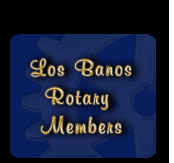




Los Banos Rotary Club History
Cut ‘em
out - Rotarians visit horse training facility
By Serena Zelezny
It is considered one of the latest growing equine sports in the world, but the
local Rotary club had its first experience with “cutting” horses during
a field trip to the ranch on Tuesday afternoon.
Local cutting horse
trainers Steve and Robin Kovacs hosted the local professionals at their training
facility off of Ward Road, giving a full demonstration of the sport of “cutting.”
Using four of the facilities competition mares, or female horses, all of
different ages, lead trainer Steve Kovacs showed the Rotarians what it means to
“cut” cattle.
With speed, agility and great athleticism, the
horse and rider work together to separate a single cow from a herd, using quick
stops and turns to prevent the cow from rejoining the others.
The goals
is for horse and rider to work together without showing any visible signals with
the reins. Some Rotarians noticed that it appears the horse does all the work
while the rider sits in the saddle for the ride.
Robin Kovacs reassured
the spectators that it actually takes a great deal of effort on the rider’s
part. Even the slightest movements or readjusting of the rider’s weight
are read as cues by the horse.
The Kovacs explained to the visiting group
that the sport is derived from the traditional American cowboy who used cutting
techniques when branding cattle in a herd.
The National Cutting Horse Association
was created in 1946, developing the modern cutting horse competitions, now held
in all 50 states as well as in foreign countries.
The Kovacs said today’s
cutting horse and rider teams only have two-and-a-half minutes to cut two or three
cattle.
The cut can be considered complete when the calf turns away
from the horse, no longer attempting to rejoin the others.
Steve and
Robin Kovacs put their horses through several years of training before showing
them in NCHA futurities and major competitions.
“There is a lot of work
involved,” said Steve Kovacs. “This is the fun part.”
Robin
Kovacs said she and her husband, who have been training horses in Los Baños
for a year and a half, ride 18 horses per day, primarily quarter horses, preparing
them for shows or cutting horse sales.
Though race horses are more commonly
known for their large price tag, the Kovacs said cutting horses are certainly
not inexpensive.
The youngest horse used in Tuesday’s demonstration
will be heading her first sale. Steve Kovacs said if she isn’t sold for
at least $100,000 she will be returning to the ranch in Los Baños.
They said some are sold for more than $1 million.
The Rotarians
asked the trainers about the bond between horse and rider, imagining it would
be difficult to train a horse then sell her.
Robin Kovacs said it is
difficult, but compared it to sending children off to college.
“It
is a great feeling to see our horses go off and win a bunch of money (in a competition),”
she said. “Plus, then I wouldn’t ever be able to train another horse.”
Steve Kovacs agreed that horse training is similar to working with children
in other aspects as well. Each horse has their own personality and grows as they
learn through the training process.
“They are like kids, too,”
he said. “But that’s what makes it fun for us – you never know
(how they will behave) day to day.”
But both Steve and Robin have
been in the business for years, and despite the fact that there are few major
competitions in the area, they show no signs of letting up anytime soon.
They have a pasture full of babies that will be ready for training before
too long. They also have a stallion, Smart Peppy Dog, who is away at another training
facility.
“This is the (most fun) thing I’ve ever done,”
Robin Kovacs said.
© Copyright 2009 by
Los Banos Enterprise, Rotary Club 585 & Memorable Places Web Design of Los Banos


